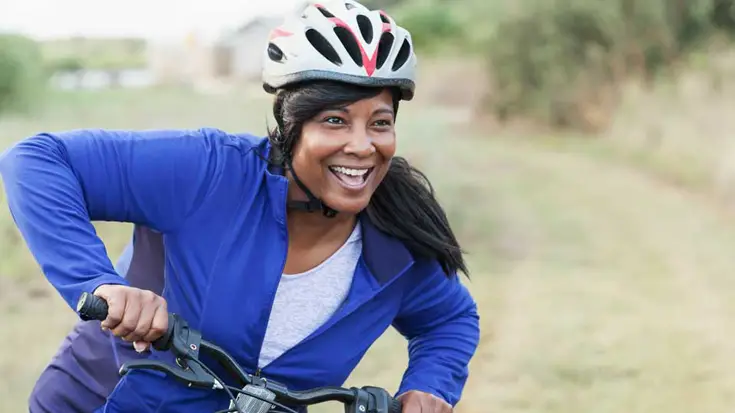What is an approved lock and why do you need one?
Chances are you know someone who's had their bike stolen at one time or other, so it’s important to follow the correct security measures to keep your bike safe.
If you leave your bike unattended or don’t lock it properly – through the frame and any quick-release wheels to an immovable object using an approved lock – it could invalidate your insurance and, should your bike get stolen, you may not be covered.
According to the Master Locksmiths Association, an ‘approved lock’ can be any of the following, as long as it’s less than two-years old when you take out your bicycle insurance policy, and is listed on the approved locks page:
- A keyed armoured cable lock
- A keyed chain lock set
- A keyed D-lock or U-lock
You’ll also need to provide at least one of the following items in the event of a claim:
- The key to your approved lock
- A receipt for the approved lock
- A clearly identifiable photo of the key and lock
- The remains of the lock that was broken when your bicycle was stolen

Check the insured value of your bicycle and make sure you correctly secure it with the following lock:
- Value less than £1,000 – you need a Sold Secure Silver Rating lock
- Value over £1,000 – you need a Sold Secure Gold Rating lock
Tips on bike security
Locking your bike in-transit
When you’re travelling with your bike, make sure you follow important security measures to keep it safe. If it’s left unattended while it’s in a motor vehicle, or attached to a motor vehicle (including while it’s in transit), it must be either:
- Locked inside an enclosed boot, or
- Locked through the frame and wheels to a secure anchor point (a child restraint or door handle) inside a securely locked vehicle, or
- Locked and secured using a properly fitted, lockable bike rack, or
- Locked through the frame of the bike to a bike rack using an approved lock, or
- Kept inside a fully-enclosed trailer which is securely locked by a closed shackle padlock or the trailer’s secure locking system
Don’t forget your kit
When you lock up your bike, don’t forget to take your cycling accessories with you.
Your lights, GPS tracker, panniers and toolkit are easy for thieves to take, and aren’t covered on their own. Any claim you make for loss or damage to your cycling accessories is only valid as part of a larger claim - for example, if your bike was also stolen/damaged in the same incident.
So, if you’re locking your bike up while you enjoy a post-ride coffee, make sure you take your valuables with you.
Don’t abandon your bike
Your bike is considered ‘unattended’ if it’s out of your direct line of sight and/or more than five metres away from you.
If you leave your bike unattended, it must be securely locked through the frame of the bike and any quick-release wheels to an immovable object by an approved lock.
If not, your bike will be considered ‘abandoned’ and you will not be covered for theft or damage.
- In an unlocked vehicle
- In the secure (transition) zone of an event for over 24 hours
- At your permanent place of work for more than 24 hours
- At a train station for longer than 24 hours
- In any other location for more than 18 hours
Please note, even if you have locked your bike securely in a public place, at a train station or at your work, it won’t be covered if you’ve exceeded the time limit.
Buy the correct lock
You get what you pay for when it comes to bicycle locks. Cheap locks don’t offer much protection from thieves and will invalidate your insurance policy if your bike is stolen. Make sure you get the approved lock for the value of your bike, so your bicycle will be harder to steal. And, in the event that it is stolen, you’ll be covered. Remember:
- D-locks (sometimes called U-locks) are the most durable and secure locks around
- Cable and combination locks can be cut easily
Make sure your lock is weather-proof, too. Rust can weaken the lock and make it easier to break.
Store your bike properly at home
Wherever you keep your bike when you’re not using it, you must follow the correct storage requirements:
In your home
If you keep your bike inside your home, make sure all the doors and windows are securely locked whenever it’s unoccupied. Doors must be locked by a minimum 5 lever Mortice lock, a CEN Grade 3 closed shackle padlock, or a Chubb deadlock must be in operation on the door.
In an outbuilding, such as a garage or shed
If the outbuilding or garage isn’t attached to your home, it must be fully-enclosed (with walls and a roof). The walls and doors must be solid and robust, and any windows or doors must be locked by a minimum 5 lever Mortice lock, a CEN Grade 3 closed shackle padlock, or a Chubb deadlock must be in operation on the door while you’re not there. If you’re using a metal shed, it must be permanently fixed to a concrete base and securely locked using a minimum three- point locking system.
Communal areas
If you leave your bike in a communal area such as a parking garage or the foyer of your building, it must be secured to an immovable object using an approved lock through the frame and all quick-release wheels. It must not be visible from outside the building, or to anyone passing by.
In a bicycle hanger
If you’re using a secure bicycle hanger to store your bike, the unit must be located within a one-mile radius of your home and securely locked. Inside the hanger, you need to securely lock your bike through its mainframe and all quick-release wheels to an immovable object using an approved lock.
A word about bike racks
If you’ve ever felt the panic as you drive into the garage, suddenly realising your bike is still on the roof rack, don’t worry! We’ll cover your bicycle when it’s being transported on a roof rack or on the back of your car.
The same is true with indoor car parks or low bridges. It’s a standard feature of our Bicycle Cover. As long as your bike is fastened securely to the rack, you’re covered.
Frequently asked questions
An approved lock means any bicycle, motor scooter or motorcycle lock used on your bicycle that has been tested and approved by ‘Sold Secure’ and is the correct rating relevant to the value of your bicycle.
If your bicycle has an insured value of less than £1,000, you must correctly secure it with a Sold Secure Silver rated lock.
If your bicycle has an insured value of, or greater than £1,000 in value, you must correctly secure it with a Sold Secure Gold rated lock.
You can view approved locks on the Sold Secure website.
- A brick, concrete or stone house of standard construction with a slate, tiled or multi layered roof
- A self-contained flat within a brick, concrete or stone building of standard construction with a slate, tiled or multi layered roof.
- A communal area being an area of shared use within the building stated on Your Schedule as your primary residence which is not visible from outside the building and/or visible to the General Passing Public and is only accessible by you and others who also permanently live in the building.
- A self-contained lockable private room in the halls of residence where you live.
- A privately accessed, fully enclosed, outbuilding or garage built of brick, concrete or stone and roofed with slate, tiles or multi layered roof, which is attached to or within the boundaries of a private house securely locked by a minimum of a 5 lever Mortice or Chubb deadlock to BS3621 standard or a CEN Grade 3 closed shackle padlock and have securely locked windows.
- A privately accessed and securely locked wooden shed, within the secured boundaries of your primary residence, provided the bicycle inside is secured to an immovable object through the frame and any quick release wheels with an approved lock.
- Any temporary residence such as a holiday cottage/home, guesthouse, hotel or B&B for a maximum period of 30 days during the Period of Insurance, providing the area of the temporary residence is self-contained and secured to the same standard as your primary residence.
Latest articles

Why is cycling good for your mental health?
It's more important than ever to look after our mental health. Luckily, there are lots of ways to help keep yourself in a good headspace, and cycling is right up there among the best.

E-bikes: why they're taking over the UK cycling scene
Electric bikes, have seen a huge increase in sales over the past couple of years.But what exactly is an e-bike and why are they so popular?

7 reasons why cycling is the best post-lockdown exercise
After a year without the usual distractions of a daily commute and busy social lives, the pandemic gave many of us the chance to look inward, re-evaluate our lives, prioritise our health and set new goals.
